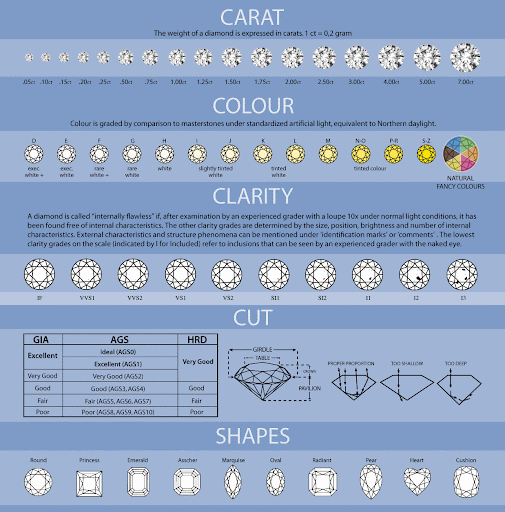Many factors go into selecting a diamond, whether for an engagement ring or simulated diamond jewelry. The 4Cs of diamond grading can help you choose the best diamond. Cut, color, clarity, and carat are the 4Cs. Knowing how diamond grading affects quality will help you choose a stone within your budget.
In general, a stone's rarity and value increase as its grades improve. Internally flawless diamonds are rare and expensive. The diamond's cut affects its ability to shine and sparkle the most. Poor cutting can dull even the best diamonds. The rarest, flawless diamonds have no visible color or hues. Carat size is a diamond's weight and size. Finally, clarity is checked for flaws.
These four factors affect the quality and value of mined and lab-grown diamonds. Each affects the price of a diamond, but trade-offs can be made to stay within your budget. Clarity is one of the four main factors to consider when buying a diamond or diamond alternative.

Diamond clarity grading evaluates any surface or internal flaws. How are diamonds made? explains clarity.
Natural diamonds are formed by heating and compressing carbon deep within the earth, which can cause flaws. These defects include blemishes and inclusions. Diamond clarity is the least important factor when buying a diamond because most stones have microscopic blemishes and inclusions. Clarity is the absence of these flaws.
Diamond blemishes include scratches and nicks. Inclusions are trickier. In some cases, they may break through the stone's surface. Some inclusions are tiny diamonds or mineral crystals trapped inside a diamond. Depending on their location, these inclusions may affect the stone's appearance after it's been cut and polished. Multiple factors affect a diamond's sparkle.
GIA created the standard for grading diamond clarity. The clarity scale has 11 grades in 6 groups. Gemologists must determine the number, size, relief, nature, and position of any blemishes or inclusions to evaluate a diamond's clarity. No diamond is perfect, but many flaws are too small to see without training. The closer a diamond is to perfection, the higher its value. GIA's clarity chart has six categories.
A gemologist considers several factors to determine a diamond's clarity grade. These are mostly diamond inclusions:
These factors determine a diamond's clarity. Shape, proportions, and facet arrangement can obscure or highlight flaws. Poor clarity isn't fatal for every diamond.
Sell your diamonds with ease with Diamond Registry’s comprehensive approach and vast global industry connections to help you find the best buyer for your diamond fast. Visit www.diamondregistry.com/sell-your-ring to take your first step to fast, easy and reliable way of selling your diamond.
Want to check and calculate diamond per carat instantly? Go to DR’s diamond price calculator www.diamondregistry.com/diamond-price-list/#calc-move-to to know how. Reliable and trusted carat calculator in the diamond industry since!

